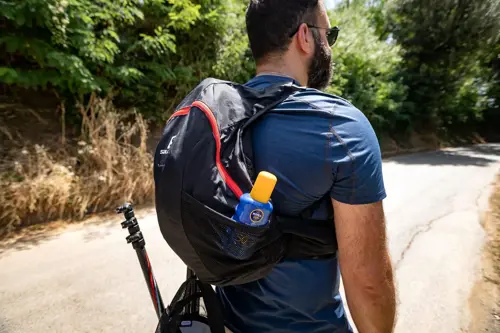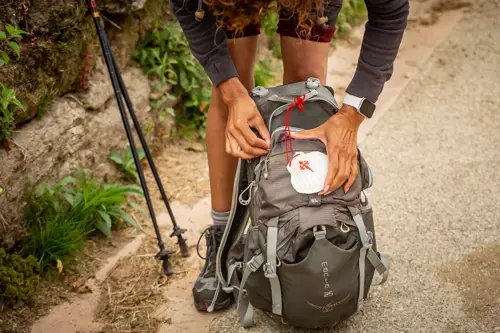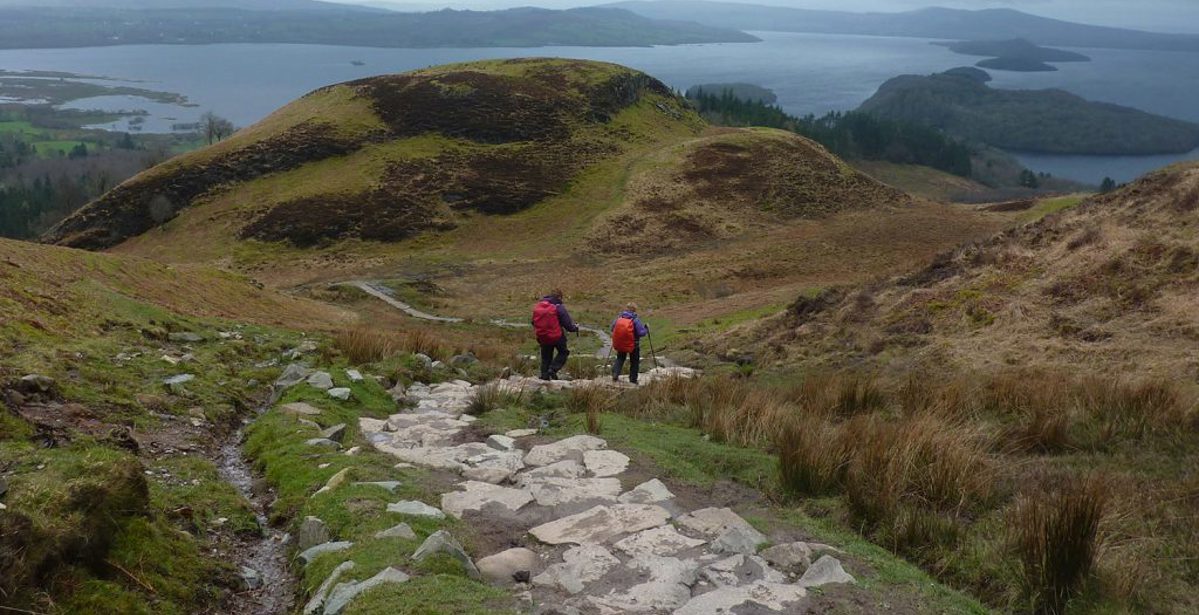Not sure what to pack for your hiking vacation with Macs? Our essentials packing list will guide you.
One of the biggest differences between a Macs self-guided trip and going on your own is that we’ll transfer your luggage between destinations. That means you’ll want to pack a little differently, so you have a daypack with all your adventure essentials, and a main piece of luggage you’ll only have access to in the mornings and evenings at your accommodations.
Use this checklist to make sure you pack everything you need for your hiking trip.

Hiking Essentials List
We recommend bringing two bags: One piece of luggage for all your overnight gear, which will be transferred between your accommodations by a local partner, and one trail-ready daypack for hiking or biking.
You can usually pack up to 44 lbs (20 kg) in your overnight bag (double-check your welcome pack to confirm). That means you have plenty of room to bring an outfit or two for nice dinners, and some extra clean layers for your hike. Always pack weather-appropriate apparel for both the trail and the town, plus extra layers in case the weather is colder, warmer, or wetter than you expect it to be.
Macs offers several different kinds of trips for every type of adventurer, and the balance of active to lifestyle garments you’ll need varies by trip. For a Classic Route or Pilgrimage, you’ll spend more time on the trail and less time in town, so you’ll probably want to bring more active layers. For an In Style or Slower Adventure, you’ll have more time to explore the towns where you’re staying, so you may want more jeans, dresses, or dinner apparel if you’re planning a special treat.

Regardless of the balance, you’ll want to cover all the basics:
Activewear and Outerwear for Hiking
-
Hiking pants, leggings, and/or shorts
-
Wool or synthetic base layers
-
Midlayers
-
Wool hiking socks
-
Sturdy, waterproof hiking boots
-
Sandals or water shoes, if applicable
-
Lightweight and breathable underwear
-
Sports bra
-
Waterproof trousers
-
Rain jacket
-
Lightweight windbreaker or shell jacket
-
Gaiters (if hiking in a very muddy place)
Accessories and Cold-weather Gear (If Applicable)
-
Beanie hat
-
Waterproof gloves
-
Neck gaiter

Travel Essentials
International travel always requires a bit of extra legwork. As soon as you book your trip, make sure to double-check visa and vaccination requirements for your destination so that you have plenty of time to apply for documents if needed. You usually need at least six months of lead time on your passport in order to enter a foreign country. The U.S. State Department regularly updates its website with travel warnings and essential documents for the rest of the world, and you can also sign up for traveler alerts so you’ll get notified if travel restrictions or a significant weather event could impact your trip.
Don’t forget to double-check your airline’s luggage requirements to make sure you don’t miss the weight limit or cutoff time for checking a bag. Hiking poles usually need to go in your checked luggage, while electronic devices with rechargeable batteries like cameras, headlamps, e-readers, tablets, laptops, cell phones, and external battery packs need to go in your carry-on luggage.
Make sure you have:
-
Passport with essential visa(s)
-
Universal travel adapter so you can use all of your devices
-
Chargers for your devices
-
Credit card and/or debit card (ideally one that doesn’t charge foreign transaction fees) to minimize exchange fees
-
Cash—bring a small amount in your own currency so you can convert it if necessary. You may also be able to get foreign currency from your local bank for a fee.
-
Toiletries—avoid single-use plastic by bringing your own essentials. Don’t forget sunscreen!
-
Medication
-
Travel insurance, in case of delays, illness, or trip cancelation
Essential Daytime Adventure Gear
During the day, you only need to carry water, snacks, sunscreen, a small first aid kit with essentials like blister plasters like Compeed or Moleskin, and your map and guidebook. You should also bring extra layers such as a light rain jacket and rain pants when necessary. Don’t forget to fully charge your phone and bring an extra battery pack so you can access the Macs app throughout your hike.
Everything else can go in your overnight bag, which will be transported to your accommodation for you.
Choosing the right daypack will depend on your trip. For shorter distances or walking through populated areas where you’ll have ample opportunities to dine out or buy snacks, a small daypack may be enough for you. If you’re hiking longer miles in a more remote area, you may want a bigger pack with a hip belt so you have space for extra layers, snacks, and more water. Scout out your route ahead of time by consulting the Macs app and your guidebook to check what options you’ll have for refreshments during the day.

You may also want:
-
Hiking poles
-
Water bladder and/or reusable filtration bottle
-
Camera
-
Binoculars, if you’re into birding or wildlife spotting
-
A small journal or notebook for note-taking
-
A book or e-reader
Choosing the Right Luggage for Your Self-Guided Hiking Trip
You can pack up to 44 lbs in your overnight bag, but that doesn’t mean you have to fill it. And you probably shouldn’t—you’ll want to leave room to bring home local treats or gifts from your adventure. You also don’t want to waste an hour each morning trying to zip up an overstuffed suitcase.
Choose a piece of luggage that will easily fit all of your essentials plus a little extra. Make sure you weigh it before you leave, and that you comply with luggage restrictions for your airline, which may be different from Macs guidelines.
How to Pack Your Luggage Strategically
Packing cubes and stuff sacks can help you minimize the amount of time you spend organizing your luggage. They can also help you separate your clean and dirty clothes so your dinner outfit stays fresh and protected from any muddy hiking clothes if you get caught in the rain.
Pack your most frequently used items on top, and any just-in-case items you’re less likely to need on the bottom.
When to Start Packing
Weather can change quickly, and dramatically. You may be staring down a forecast for steady rain a week before your trip, and it could turn to sunshine just a few days prior. You may want to pack a few days before you leave, and then check the weather again the evening before departure so you can add an extra layer if needed.
Don’t forget to research your destination before you go, so you can make sure to pack appropriate clothes for events, museums, restaurants, or religious sites you want to visit.
If you need to buy new clothes or gear before you head off on your trip, do that as soon as possible so that you have time to try out your new clothes and make sure they fit comfortably. Give yourself several weeks to break in new hiking boots, and always treat hot spots with preventative blister care so you don’t ruin your trip before it even starts.
Planning in advance can help make your adventure with Macs the smoothest trip you’ve ever taken. Consider printing out this list a week before you leave to double-check you’ve got everything you need. And of course, if you have any lingering questions about what to bring—and what to leave behind—never hesitate to call or email us.






 Canada
Canada